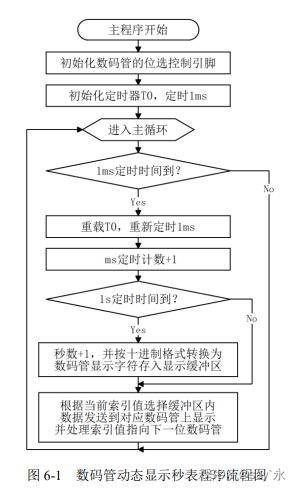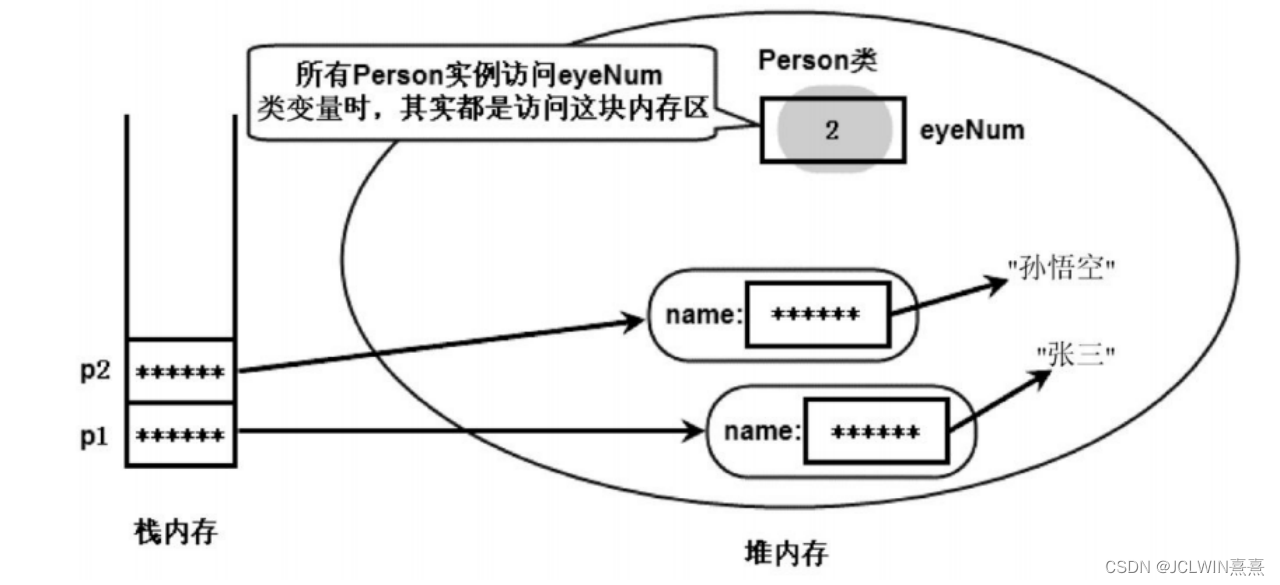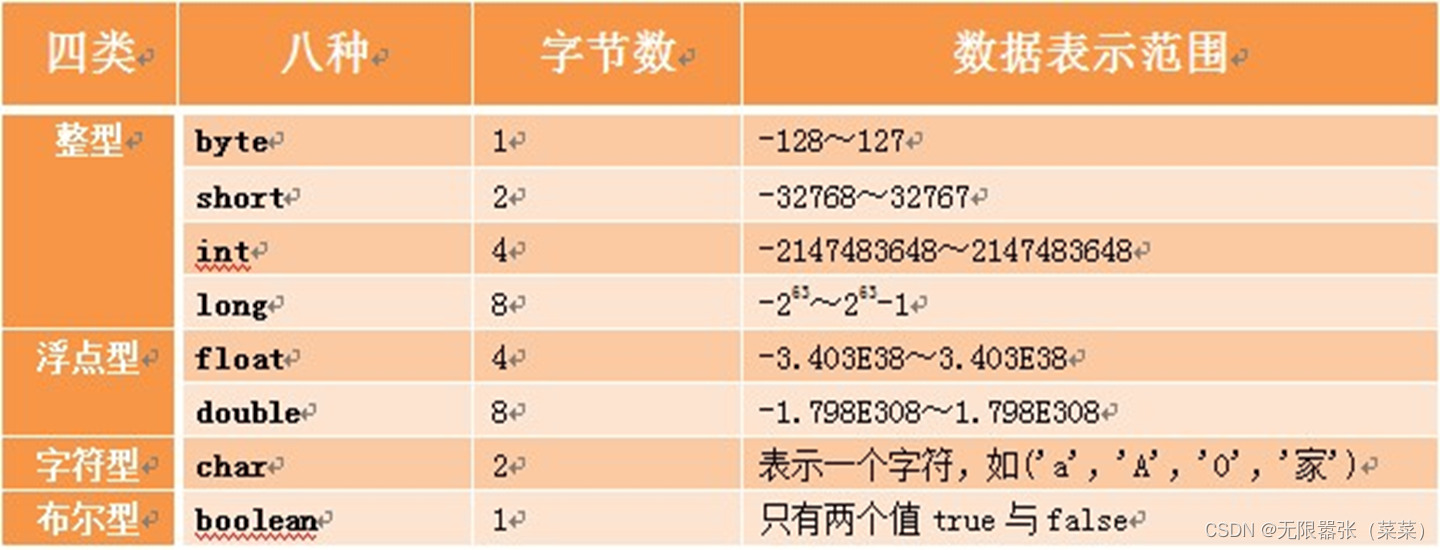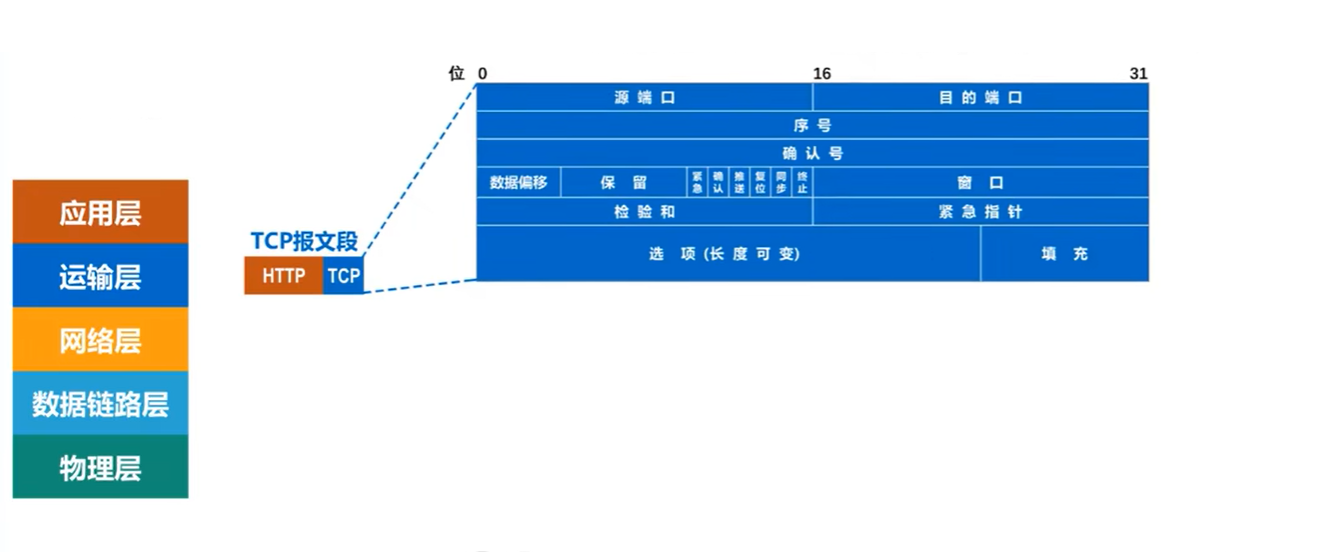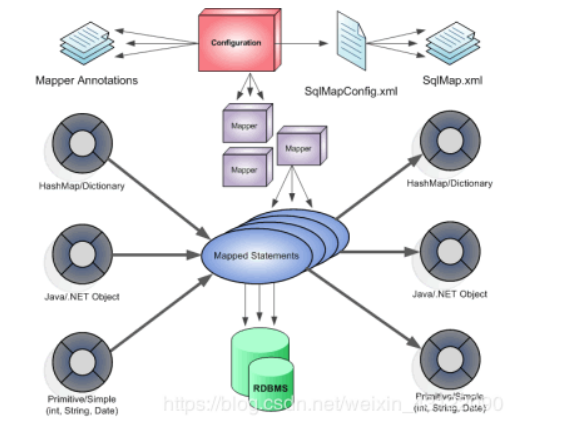目录
- 1.多线程的创建和启动方式
- 1.线程第一种启动方式(继承Thread类)
- 2.多线程的第二种启动方式实现Runnable接口
- 3.多线程的第三种启动方式实现Callable接口
- 2.Thread多线程中的方法
- 1.getName(), setName(),currentThread(),sleep
- 2.Thread优先级调度方法
- 3.守护线程
- 4.出让线程/礼让线程
- 5.插入线程/插队线程
多线程涵盖的基本概念:链接: 程序进程和线程(线程的并发与并行)
1.多线程的创建和启动方式

1.线程第一种启动方式(继承Thread类)
//Thread第一种启动方式
//1.定义一个类继承Thread类
//2.重写run方法
//3.创建子类的对象,并启动线程
package threadDemo01;
public class test01 {
//Thread第一种启动方式
//1.定义一个类继承Thread类
//2.重写run方法
//3.创建子类的对象,并启动线程
public static void main(String[] args) {
myThread t1=new myThread();
myThread t2=new myThread();
t1.setName("线程1");
t2.setName("线程2");
t1.start();//启动线程
t2.start();//启动线程
}
}
package threadDemo01;
/**
* @version 1.0
* @auther Demo龙
*/
public class myThread extends Thread{
@Override
public void run() {
for (int i = 0; i < 20; i++) {
System.out.println(getName()+"jhsgdf");
}
}
}

2.多线程的第二种启动方式实现Runnable接口
/*
* 多线程的第二种启动方式Runnable
* 1.定义一个类继承Runnable接口
* 2.重写run方法
* 3.创建子类的对象
* 4.创建一个Thread类的对象,并开启线程
* */
package threadDemo02;
/**
* @version 1.0
* @auther Demo龙
*/
public class test02 {
public static void main(String[] args) {
/*
* 多线程的第二种启动方式Runnable
* 1.定义一个类继承Runnable接口
* 2.重写run方法
* 3.创建子类的对象
* 4.创建一个Thread类的对象,并开启线程
* */
//1.创建myRunnable对象
myRunnable r1 = new myRunnable();
myRunnable r2 = new myRunnable();
//2.创建线程对象
Thread t1=new Thread(r1);
Thread t2=new Thread(r2);
t1.setName("线程1");
t2.setName("线程2");
t1.start();//启动线程
t2.start();//启动线程
}
}
package threadDemo02;
/**
* @version 1.0
* @auther Demo龙
*/
public class myRunnable implements Runnable{
@Override
public void run() {
for (int i = 0; i < 20; i++) {
Thread t=Thread.currentThread();
System.out.println(t.getName()+"ksjdhg");
}
}
}
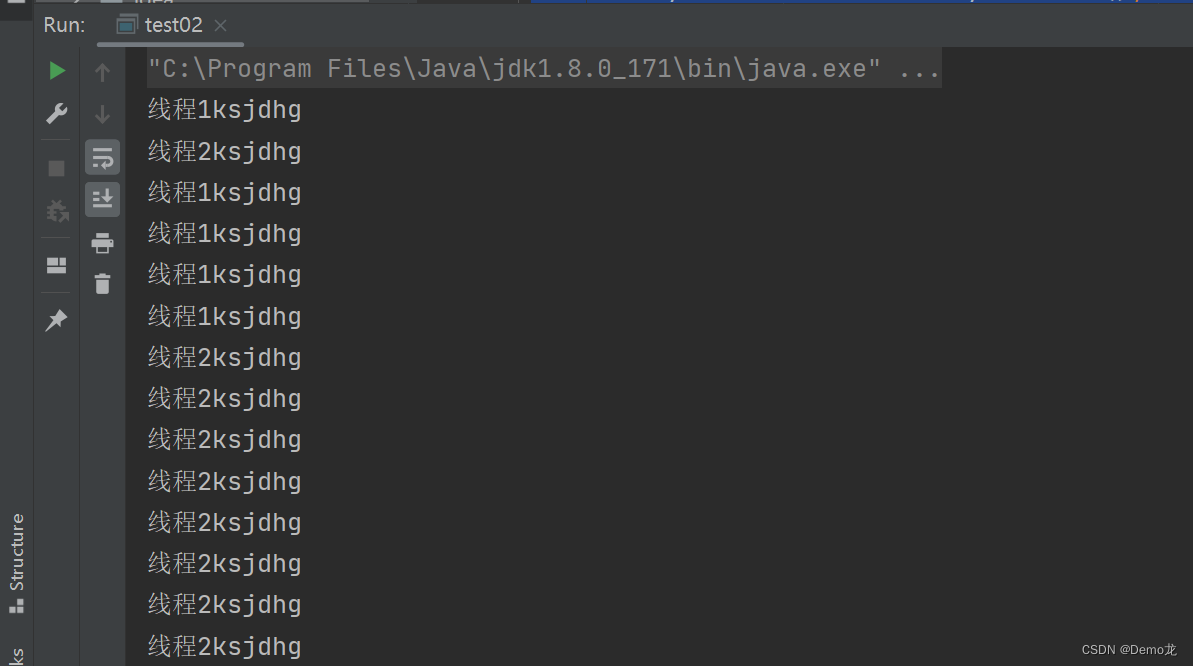
3.多线程的第三种启动方式实现Callable接口
- 多线程的第三种启动方式:
* 特点:可以获取到多线程运行的结果。
* 1.创建一个类myCallable实现Callable接口
* 2.重写call方法(有返回值)
* 3.创建myCallable对象(表示多线程要执行的任务)
* 4.创建FutureTask对象(作用:管理多线程运行的结果)
* 5.创建Thread类的对象并启动。(表示线程)
package threadDemo03;
import java.util.concurrent.ExecutionException;
import java.util.concurrent.FutureTask;
/**
* @version 1.0
* @auther Demo龙
*/
public class test03 {
public static void main(String[] args) throws ExecutionException, InterruptedException {
/*
* 多线程的第三种启动方式:
* 特点:可以获取到多线程运行的结果。
* 1.创建一个类myCallable实现Callable接口
* 2.重写call方法(有返回值)
* 3.创建myCallable对象(表示多线程要执行的任务)
* 4.创建FutureTask对象(作用:管理多线程运行的结果)
* 5.创建Thread类的对象并启动。(表示线程)
* */
//3.创建myCallable对象(表示多线程要执行的任务)
myCallable mc = new myCallable();
//4.创建FutureTask对象(作用:管理多线程运行的结果)
FutureTask <Integer>ft = new FutureTask<>(mc);
//5.创建Thread类的对象并启动。(表示线程)
Thread t1=new Thread(ft);
t1.start();
//6.获取多线程运行的结果
Integer result=ft.get();
System.out.println("result="+result);
}
}
package threadDemo03;
import java.util.concurrent.Callable;
/**
* @version 1.0
* @auther Demo龙
*/
public class myCallable implements Callable<Integer> {
@Override
public Integer call() throws Exception {
int sum=0;
for (int i = 0; i < 20; i++) {
sum+=i;
}
return sum;
}
}

2.Thread多线程中的方法
1.getName(), setName(),currentThread(),sleep
getName()Theard 类中得到线程名字的方法
setName设置线程的name(如果没有给线程设置名字,默认为Thread-X(从0开始))
static Thread currentThread().返回当前线程的对象
/*细节
* 1.当JVM机启动之后,会自动启动多条线程
* 其中有一条就叫做main线程
* 它的作用就是调用main方法,并执行里面的代码
* 以前我们所写的代码,其实就是运行在main线程当中。
* */static void sleep(long time)让线程指定休眠时间,单位为毫秒
/*细节
* 1.哪条线程执行到这个方法,那么哪条线程就会在这里停留对应时间
* 2.方法参数:ms,
* 3.时间到了以后,线程继续执行下面的其他代码
* */
package threadMethod01;
/**
* @version 1.0
* @auther Demo龙
*/
public class test01 {
/*
*
* */
public static void main(String[] args) throws InterruptedException {
//创建线程对象
myThread t1=new myThread();
myThread t2=new myThread();
//1.setName设置线程的name(
// 如果没有给线程设置名字,默认为Thread-X(从0开始))
t1.setName("线程1");
t2.setName("线程2");
t1.start();//启动线程
t2.start();//启动线程
//3.static Thread currentThread().返回当前线程的对象
/*细节
* 1.当JVM机启动之后,会自动启动多条线程
* 其中有一条就叫做main线程
* 它的作用就是调用main方法,并执行里面的代码
* 以前我们所写的代码,其实就是运行在main线程当中。
* */
Thread t = Thread.currentThread();
System.out.println("t="+t);
System.out.println("t.getName()="+t.getName());//main
//4.static void sleep(long time)让线程指定休眠时间,单位为毫秒
/*细节
* 1.哪条线程执行到这个方法,那么哪条线程就会在这里停留对应时间
* 2.方法参数:ms,
* 3.时间到了以后,线程继续执行下面的其他代码
* */
Thread.sleep(5000);//休眠5秒
System.out.println("8888888888888888888888");
}
}
package threadMethod01;
/**
* @version 1.0
* @auther Demo龙
*/
public class myThread extends Thread{
@Override
public void run() {
for (int i = 0; i < 20; i++) {
//2.getName()Theard 类中得到线程名字的方法
System.out.println(getName()+"@"+i);
}
}
}
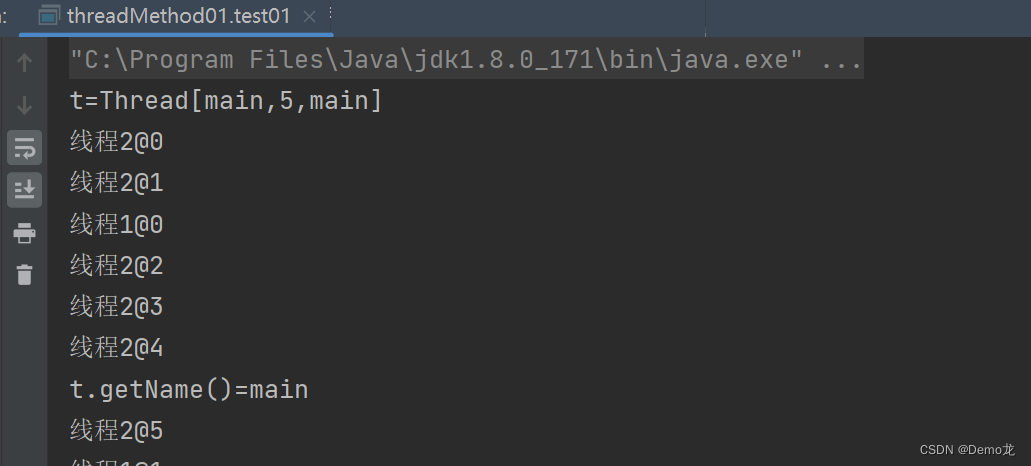
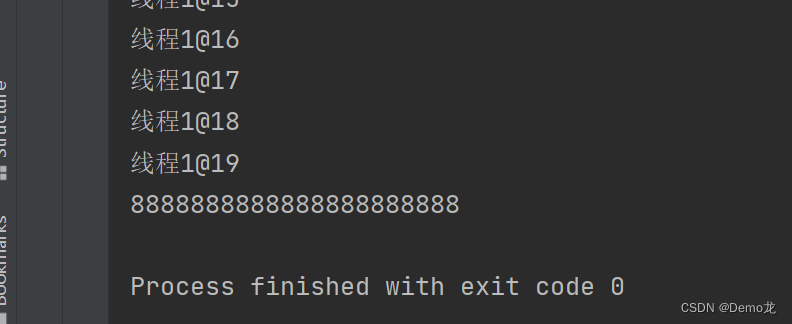
2.Thread优先级调度方法
/*抢占式调度()随机
* 1.setPriority(int newPriority) 设置线程的优先级
* 2.getPriority() 获取线程的优先级
* */
package threadMethod02;
/**
* @version 1.0
* @auther Demo龙
*/
public class test02 {
/*抢占式调度()随机
* 1.setPriority(int newPriority) 设置线程的优先级(1-10)
* 2.getPriority() 获取线程的优先级
* */
public static void main(String[] args) throws InterruptedException {
//创建线程要执行的参数对象
myThread02 r=new myThread02();
//创建线程对象
Thread t1=new Thread(r,"坦克");
Thread t2=new Thread(r,"飞机");
//查看默认优先级=5
System.out.println(t1.getPriority());//5
System.out.println(t2.getPriority());//5
System.out.println(Thread.currentThread().getPriority());//5
//设置默认优先级
t1.setPriority(10);//优先级最高
t2.setPriority(1);//优先级最低
t1.start();
t2.start();
}
}
package threadMethod02;
/**
* @version 1.0
* @auther Demo龙
*/
public class myThread02 implements Runnable{
@Override
public void run() {
for (int i = 0; i < 100; i++) {
System.out.println(Thread.currentThread().getName()+"@"+i);
}
}
}
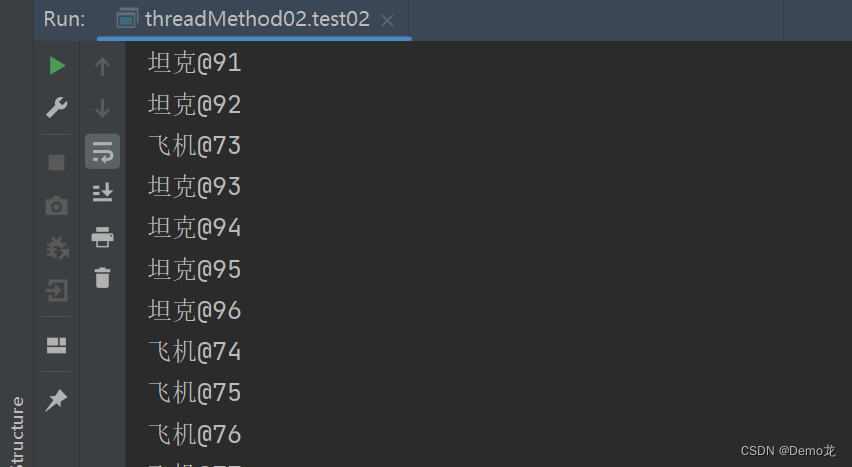
3.守护线程
/*
* final void setDaemon(boolean on) 设置为守护线程
* 细节:当其他的非守护线程执行完毕后,守护线程会陆续结束(不是立即)。
* */
package threadMethod03;
/**
* @version 1.0
* @auther Demo龙
*/
public class test03 {
public static void main(String[] args) throws InterruptedException {
/*
* final void setDaemon(boolean on) 设置为守护线程
* 细节:当其他的非守护线程执行完毕后,守护线程会陆续结束(不是立即)。
* */
//创建线程对象
myThread1 t1=new myThread1("飞机");
myThread2 t2=new myThread2("坦克");
//设置为守护线程
t2.setDaemon(true);//(设置t2为备胎,其他非备胎结束了,t2也慢慢(时间不一)会结束)
t1.start();
t2.start();
}
}
package threadMethod03;
/**
* @version 1.0
* @auther Demo龙
*/
public class myThread1 extends Thread{
public myThread1() {
}
public myThread1(String name) {
super(name);
}
@Override
public void run() {
for (int i = 0; i < 10; i++) {
System.out.println(Thread.currentThread().getName()+"@"+i);
}
}
}
package threadMethod03;
/**
* @version 1.0
* @auther Demo龙
*/
public class myThread2 extends Thread{
public myThread2() {
}
public myThread2(String name) {
super(name);
}
@Override
public void run() {
for (int i = 0; i < 100; i++) {
System.out.println(Thread.currentThread().getName()+"@"+i);
}
}
}
4.出让线程/礼让线程
/*
*public static void yield();出让线程/礼让线程
* */
//表示出让(礼让)当前CPU的执行权
//尽可能让结果均匀
Thread.yield();
package threadMethod04;
/**
* @version 1.0
* @auther Demo龙
*/
public class test {
/*
*public static void yield();出让线程/礼让线程
* */
public static void main(String[] args) throws InterruptedException {
//创建线程对象
myThread t1=new myThread();
myThread t2=new myThread();
t1.setName("线程1");
t2.setName("线程2");
t1.start();//启动线程
t2.start();//启动线程
}
}
package threadMethod04;
/**
* @version 1.0
* @auther Demo龙
*/
public class myThread extends Thread{
@Override
public void run() {
for (int i = 0; i < 20; i++) {
System.out.println(getName()+"@"+i);
//表示出让(礼让)当前CPU的执行权
//尽可能让结果均匀
Thread.yield();
}
}
}
5.插入线程/插队线程
/*
*public static void join();插入线程/插队线程
t1.join();//表示把t1这个线程插入到当前线程之前
//当前线程:正在运行的线程
* */
package threadMethod05;
/**
* @version 1.0
* @auther Demo龙
*/
public class test {
/*
*public static void join();插入线程/插队线程
* */
public static void main(String[] args) throws InterruptedException {
//创建线程对象
myThread t1=new myThread();
t1.setName("恐龙");
t1.start();//启动线程
t1.join();//表示把t1这个线程插入到当前线程之前
//当前线程:正在运行的线程
for (int i = 0; i < 20; i++) {
System.out.println("main线程"+i);
}
}
}
package threadMethod05;
/**
* @version 1.0
* @auther Demo龙
*/
public class myThread extends Thread{
@Override
public void run() {
for (int i = 0; i < 20; i++) {
System.out.println(getName()+"@"+i);
}
}
}
